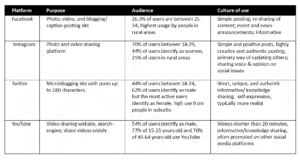Part III: Virtual Engagement at Length
Guest Blog by Emily Singerhouse
When someone says, “Virtual Engagement,” what comes to mind for you? Most people think of social media or texting. While this is accurate, virtual engagement is a diverse form of communication. There are four main categories of virtual engagement:
- Social Networking
- Teleconferencing
- Telecommunication and Broadcasting
- Direct Communication Marketing
This post will focus mainly on social networking and direct communication marketing. To start off, social networking is the platform that people use to build social relationships with like-minded individuals. This includes social media platforms, websites, chatrooms, and more. For use by SARTs and other rural grantees, the following platforms and their descriptions are recommended:
As stated in Part II: Use of Virtual Engagement, choosing a platform is an incredibly important step. Although, I would recommend that you choose a platform based on your goals and intentions. Here is an example of that process:
A rural SART wants to educate the youth in the community on what happens after a sexual assault has been reported to increase the comfortability of youth to report assault and to educate. They would use Instagram and YouTube to convey their message.
Here is why:
Instagram:
- Platform’s largest demographics are youth under 29 years old, female-identifying, and people living in rural areas
- The culture of the platform is informative and creative–ideal for culture change and educational messaging.
YouTube:
- Over 70% of youth under 25 use this platform, many users identify as male, which helps spread the message equally
- Culture of use is informational and knowledge sharing
- Videos easily be reposted on other platforms
Next, direct communication marketing is a form of communication through emails, newsletters, texting, and more. Direct communication for SARTs can look like sending email updates to team members, newsletters to community members, or texting campaigns to notify partners of events. Before choosing which form of direct communication marketing to use, keep in mind the following:
- Goals and values
- Culture and community climate in your discipline and/or region
To briefly cover, teleconferencing is largely an internal use of virtual engagement within your team. Zoom, Microsoft Teams, and Google Hangouts are popular teleconferencing platforms, which can also be used in a hybrid way. Telecommunication/broadcasting has been popular to use in PSA messaging campaigns, radio announcements, or advertisements.
No matter the chosen category, this is a new way of collaboration since the COVID-19 pandemic. It’s important to utilize these resources to make a widespread impact–internally and externally.
Sources used for this blog:
- HubSpot Blog
- Pew Research Center

